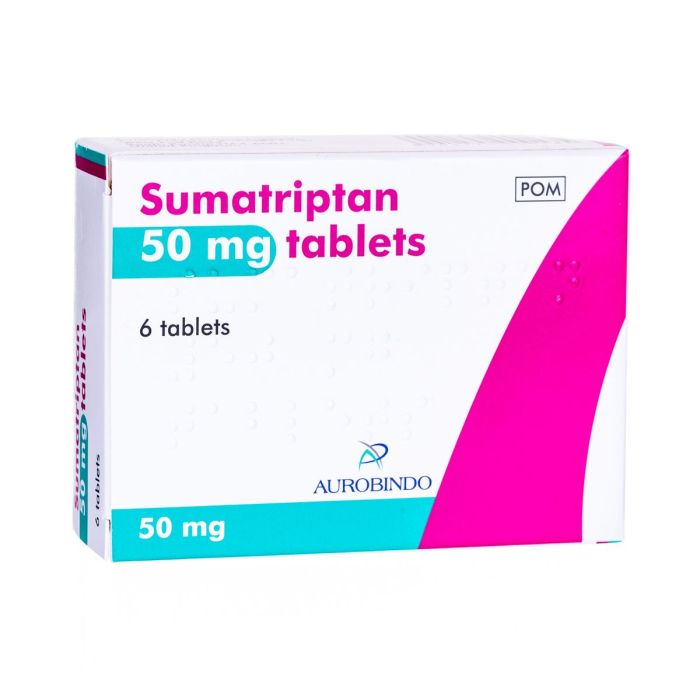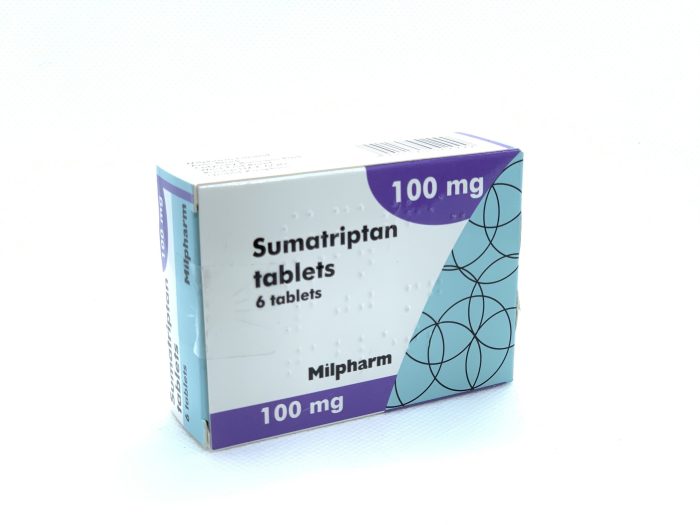Sumatriptan, a leading medication for migraine relief, offers a lifeline to millions struggling with debilitating headaches. This powerful drug works by targeting specific receptors in the brain, effectively constricting blood vessels and reducing inflammation associated with migraine attacks. Its unique mechanism of action and availability in various formulations have made it a cornerstone in migraine management, offering hope for a quicker return to a pain-free life.
Sumatriptan’s journey from discovery to widespread use has been marked by extensive research and clinical trials, solidifying its efficacy and safety. Understanding its properties, potential side effects, and proper usage are crucial for patients and healthcare professionals alike. This exploration delves into the intricacies of sumatriptan, unraveling its impact on migraine sufferers and its place in the evolving landscape of migraine treatment.
Future Directions in Sumatriptan Research
Sumatriptan, a triptan medication used to treat migraine headaches, has been a significant advancement in headache management. However, ongoing research continues to explore new avenues for improving its efficacy, safety, and accessibility.
New Formulations and Delivery Methods
New formulations and delivery methods aim to enhance the effectiveness and convenience of sumatriptan treatment. Research focuses on developing alternative routes of administration and optimizing drug release profiles.
- Nasal Spray: This formulation offers rapid absorption and avoids the first-pass metabolism, potentially leading to faster relief.
- Sublingual Tablets: These tablets dissolve under the tongue, providing a convenient and rapid absorption route, bypassing the gastrointestinal tract.
- Transdermal Patches: These patches offer sustained release of sumatriptan over an extended period, potentially reducing the frequency of administration.
Mechanisms of Action
Ongoing research delves deeper into the complex mechanisms of action of sumatriptan, aiming to understand how it effectively treats migraines.
Sumatriptan acts as a selective 5-HT1B/1D receptor agonist, constricting blood vessels and reducing the release of inflammatory neuropeptides.
- Neuroprotective Effects: Studies are investigating whether sumatriptan might possess neuroprotective properties, potentially reducing the long-term impact of migraines on brain function.
- Impact on Trigeminal Nerve: Research explores how sumatriptan interacts with the trigeminal nerve, a key player in migraine pain, to understand its analgesic effects.
Optimizing Sumatriptan Use
Further research aims to optimize the use of sumatriptan by addressing factors that influence its efficacy and safety.
- Individualized Dosing: Studies explore the potential for personalized dosing strategies based on individual patient characteristics and migraine severity.
- Combination Therapies: Research investigates the effectiveness of combining sumatriptan with other migraine medications, such as anti-nausea drugs or NSAIDs, to enhance treatment outcomes.
- Prevention Strategies: Researchers are investigating whether sumatriptan might play a role in migraine prevention, particularly in individuals with frequent or severe attacks.
Patient Education and Counseling

This pamphlet provides information about sumatriptan, a medication used to treat migraine headaches. It is important to understand how to use sumatriptan safely and effectively. Please read this information carefully and discuss any questions you may have with your doctor or pharmacist.
Understanding Sumatriptan
Sumatriptan is a triptan medication that works by narrowing blood vessels in the head and reducing inflammation. This helps to relieve the pain and other symptoms associated with migraine headaches. Sumatriptan is available in different forms, including tablets, nasal spray, and injections. The form you take will depend on your individual needs and your doctor’s recommendation.
How to Use Sumatriptan
Sumatriptan is typically taken as soon as you feel the symptoms of a migraine headache. It is important to take sumatriptan at the first sign of a migraine, as it may not be as effective if taken later.
Always follow your doctor’s instructions for taking sumatriptan.
Common Side Effects of Sumatriptan
Like all medications, sumatriptan can cause side effects. The most common side effects are mild and usually go away on their own. These side effects may include:
- Dizziness
- Drowsiness
- Weakness
- Tingling or numbness
- Warmth or flushing
Managing Side Effects
If you experience any side effects that are bothersome or do not go away, talk to your doctor.
Important Considerations
Before taking sumatriptan, it is important to discuss your medical history with your doctor. This includes any allergies, current medications, and other health conditions.
Questions to Ask Your Doctor
- What are the potential risks and benefits of taking sumatriptan?
- How should I take sumatriptan, and how often?
- What are the possible side effects of sumatriptan?
- What should I do if I experience side effects?
- What other medications can interact with sumatriptan?
- What are the long-term effects of taking sumatriptan?
- Are there any lifestyle changes I can make to help manage my migraines?
Important Information
It is important to note that sumatriptan is not a cure for migraines. It is a medication that can help to relieve the symptoms of a migraine headache.
Do not take sumatriptan if you have certain medical conditions, such as heart disease or high blood pressure.
Storage, Sumatriptan
Store sumatriptan at room temperature, away from moisture and heat. Keep it out of reach of children and pets.
Clinical Case Studies

Clinical case studies provide real-world examples of how sumatriptan is used to treat migraine headaches. They illustrate the effectiveness of the medication, potential side effects, and challenges that patients may encounter.
Case Study of a Patient with Migraine
This case study describes a 35-year-old female patient who experiences frequent migraine headaches, often accompanied by nausea, vomiting, and photophobia. She has tried over-the-counter pain relievers and lifestyle modifications, but her headaches persist. Her physician prescribes sumatriptan 100 mg tablets, to be taken orally at the onset of migraine symptoms.
Analysis of Effectiveness and Challenges
The patient reports that sumatriptan provides significant relief from her migraine headaches within 30-60 minutes of taking the medication. She notes a reduction in pain intensity and a decrease in associated symptoms like nausea and photophobia. However, she experiences occasional side effects such as dizziness and fatigue.
The patient’s experience highlights the effectiveness of sumatriptan in treating migraine headaches. It also demonstrates that side effects can occur, and patients should be aware of these potential risks. The case study also illustrates the importance of individualizing treatment plans based on patient needs and responses.
Key Features and Lessons Learned
| Feature | Description | Lesson Learned |
|---|---|---|
| Patient Demographics | 35-year-old female with frequent migraines | Sumatriptan is effective in treating migraines in a wide range of patients. |
| Migraine Symptoms | Headache, nausea, vomiting, photophobia | Sumatriptan can effectively reduce migraine symptoms, including associated symptoms. |
| Treatment Response | Significant pain relief within 30-60 minutes | Sumatriptan provides rapid relief for many migraine sufferers. |
| Side Effects | Dizziness, fatigue | Side effects can occur, and patients should be aware of these potential risks. |
| Treatment Plan | Individualized based on patient needs and responses | Treatment plans should be tailored to each patient’s specific circumstances. |
Regulatory Aspects of Sumatriptan
Sumatriptan, a triptan class medication, has undergone a rigorous regulatory approval process to ensure its safety and efficacy for treating migraine headaches. This process involves multiple phases of clinical trials, data analysis, and review by regulatory agencies.
Regulatory Approval Process
The regulatory approval process for sumatriptan, like any other medication, involves several stages:
- Pre-clinical studies: Before human trials, sumatriptan undergoes pre-clinical studies in animals to evaluate its safety and potential efficacy.
- Phase 1 clinical trials: These trials assess the safety and pharmacokinetics of sumatriptan in a small group of healthy volunteers.
- Phase 2 clinical trials: These trials evaluate the efficacy and safety of sumatriptan in patients with migraine headaches, exploring different doses and treatment regimens.
- Phase 3 clinical trials: These large-scale trials further confirm the efficacy and safety of sumatriptan compared to placebo or other treatments. The data from these trials is crucial for regulatory submissions.
- Regulatory review: Once the clinical trial data is complete, the drug manufacturer submits a New Drug Application (NDA) to the relevant regulatory agency, such as the Food and Drug Administration (FDA) in the United States. The agency reviews the data and assesses the drug’s benefits and risks.
- Approval and post-marketing surveillance: If the regulatory agency approves the NDA, sumatriptan can be marketed and prescribed. However, post-marketing surveillance continues to monitor the drug’s safety and efficacy in real-world use.
Regulatory Status in Different Countries
Sumatriptan is approved for the treatment of migraine headaches in many countries worldwide. The specific regulatory status may vary depending on the country’s regulatory agency and approval process. Here are some examples:
- United States: Sumatriptan was approved by the FDA in 1992.
- European Union: Sumatriptan was approved by the European Medicines Agency (EMA) in 1993.
- Canada: Sumatriptan was approved by Health Canada in 1994.
- Australia: Sumatriptan was approved by the Therapeutic Goods Administration (TGA) in 1994.
Impact of Regulatory Guidelines on the Use of Sumatriptan
Regulatory guidelines play a crucial role in shaping the safe and effective use of sumatriptan. These guidelines may address:
- Dosage and frequency of administration: Regulatory guidelines often specify the recommended dosage and frequency of sumatriptan based on the patient’s age, weight, and medical history.
- Contraindications and precautions: These guidelines highlight potential risks and contraindications associated with sumatriptan use, such as cardiovascular disease, uncontrolled hypertension, or pregnancy.
- Monitoring and follow-up: Regulatory guidelines may emphasize the importance of monitoring patients for adverse effects and ensuring proper follow-up care.
- Drug interactions: Regulatory guidelines often list potential drug interactions that may occur with sumatriptan, including interactions with other medications, herbal supplements, or even food.
Ethical Considerations in Sumatriptan Use
Sumatriptan, a triptan medication, is widely used for the treatment of migraine headaches. While effective for many, its use raises ethical considerations due to its potential for misuse, abuse, and the need for responsible prescribing practices. This section explores these ethical implications and strategies for promoting the responsible use of sumatriptan.
Potential for Misuse and Abuse
The potential for misuse and abuse of sumatriptan is a significant ethical concern. The drug’s ability to rapidly alleviate migraine symptoms can lead individuals to overuse it, seeking relief from headaches that may not be migraines. This can result in medication overuse headaches (MOH), a chronic headache condition caused by excessive use of headache medications.
- Individuals may also misuse sumatriptan by exceeding the recommended dosage or frequency of use, potentially leading to adverse effects and dependence.
- Furthermore, there is a risk of sumatriptan being diverted for recreational purposes, particularly in cases of illicit drug use.
These risks highlight the importance of patient education and counseling regarding the appropriate use of sumatriptan.
In conclusion, sumatriptan stands as a powerful tool in the fight against migraine. Its ability to effectively target the underlying mechanisms of migraine attacks, coupled with its diverse formulations and ongoing research, makes it a valuable option for many individuals. However, like all medications, it comes with potential risks and considerations. Understanding the complexities of sumatriptan, including its interactions with other medications, potential side effects, and appropriate usage, is paramount for ensuring its safe and effective application. As research continues to advance, the future holds promise for even more targeted and personalized migraine therapies, ultimately enhancing the lives of those affected by this debilitating condition.
Sumatriptan is a medication often used to treat migraine headaches. While it effectively tackles the pain, it’s crucial to remember that it’s not a cure. For those with underlying cardiovascular issues, a medication like coreg might be prescribed to manage blood pressure. This highlights the importance of consulting a doctor to understand your specific needs and the best treatment options for your condition, including the potential interaction between sumatriptan and other medications.